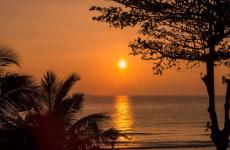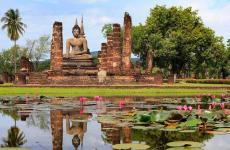In which country is the headdress called Panama? National headdress Panama
In the summer it is quite difficult to maintain sanity and a sober mind. Blame it on the scorching sun! Before you know it, your head will heat up and sunstroke will occur. But there is a salvation - a headdress or hat with large edges around the perimeter. Today we will talk about a hat - Panama, the history and essence of which is not as simple as it seems at first glance.
History of Panama
Despite the fact that the name of the hat makes us remember one small Central American country of the same name, Panama, in fact, the Panama hat has nothing to do with it.
The thing is that this headdress gained its fame during the construction of the Panama Canal among American builders. They, accordingly, brought a considerable number of Panama hats home. In the South American world, this hat is better known as the sombrero de paja toquilla. or simply “straw hat”, and its real homeland is in Ecuador, in the small town of Pila in the west of the country. Experts say that the highest quality and most comfortable Panama hats in the world are woven there.
Types of Panama hats
Despite the potential simplicity of this product, there are a huge number of types. Each type goes well with a certain style, and in some places complements it with freshness and a kind of freedom. We have chosen one of many classifications as an example.
- Bosa Blue– the embodiment of a symbiosis of elegance and simplicity. This hat is ideal for slow city life on hot days and at the same time looks very organic with most styles. Both a beach look with a Hawaiian shirt and shorts, and a casual suit with it will not hurt the eyes, but on the contrary, they will look very nice.
- Diamante– Bosa Blue’s main competitor, because its versatility borders in its absoluteness with the previous representative of this list. Actually, they differ only in that Diamante’s brim is straight, while Bosa Blue’s, on the contrary, is slightly curved in the back. Without giving a head start to its “competitor,” this hat goes well with almost everything and looks confident on any head.
- Gamber- almost a crown. With this handsome man on your head, you can do business with serious people, while remaining an elegant man in a white suit. When you wear this hat, all your requests and ideas become offers that cannot be refused. Yes, and I don’t want to, in general.
- Fedora-Calado– a hat for a gentleman who went on vacation in hot weather. Now you can stroll in style on the shore of the endless sea under the gentle streams of a light breeze with a glass of cocktail in hand, wearing summer white trousers and a light light shirt.
- Outback Macana- An excellent choice for Australian crocodile hunters and urban cowboys. If you like to spend nights by the fire in a dense forest, fishing, traveling wild in tropical countries, or simply emphasizing your brutality, then this headdress is ideal for you.

How to choose a Panama hat
The quality of a hat depends most on two factors: the quality of the straw and the quality of the weave. Straw is prepared from palm fibers and the most important thing in the selection of material is not so much the type of wood as the selection of these same straws. It is important that they are as similar as possible to each other in both thickness and length. Only then will it be possible to weave a truly strong panama hat. An equally (or even more) important role in this matter is played by the quality of weaving and the density of weaving per square centimeter. The higher the density, the higher the quality. Everything is logical!

Most often, Panama hats are divided into “Montecristi Fino” and “Montecristi Superfino” (the best and even better). This should determine the quality of the weaving, but these terms are so vague and so loosely used by some unscrupulous traders in the markets of beautiful Latin American cities that it is almost useless to navigate them. Even large manufacturers have not agreed on this issue among themselves. In order not to look at vague symbols, you can simply take and count the number of weaves per square centimeter. It's tedious, difficult, but it works.
In addition to the above quality criteria, there is one more – the so-called Vuelta. Vuelta are circles that appear around the edges of the hat when it is held against a bright source of light. For example, the sun. If you believe the tales of some Latin American sages, then the more circles and the larger they themselves are, the correspondingly higher the quality of the product. This method is probably good to some extent, but I really don’t advise you to take risks.
Prices for Panama hats
Perfection has no limits, but hatters do. The highest quality Panama hats have about two thousand weaves per square centimeter. Such incredibly sensitive and labor-intensive work takes the master from four to six months a year. Considering how much time it takes to make one such hat and the fact that there are only a dozen such hat makers left in the world, no one should be surprised by the fact that the price will be astronomical.

However, for comfortable wearing in a short period of time, a Panama hat with three to four hundred weaves will be enough and its price is unlikely to exceed a hundred dollars.
Care and storage of Panama hat
Even your grandchildren can inherit a real Panama hat if you pay due attention to it. Here are some tips:
- First, watch the band on your hat. It protects it from stretching and your forehead from scratches.
- Secondly, avoid wearing in the rain and generally avoid any contact with water, these hats do not tolerate moisture very well. Store in a dry place.
- Third, grasp the hat only by the top, not by the brim. Can greatly affect the shape.
- Fourth, when cleaning, use a brush with soft bristles.
By following these tips, you can extend the life of your hat by years.
Hatter etiquette
Great power is hidden in Panama, and, as you know, with great power comes great responsibility. Therefore, it is worth adhering to a number of rules that should be followed not only by the owner of a Panama hat, but also by the owner of any headdress.
First you need to learn how to take off your hat in time. If you are not a king, czar or shah, then when entering someone else's home, holy or religious places, it is better to remove your headdress. When greeting someone (especially a woman), it is also better to take off your hat, but as a sign of respect you can get by by simply tearing it off your head a couple of centimeters. You should also take off your hat when going to the theater, cinema or a big concert, so as not to ruin the view for anyone present. In the workplace, it is also better to go without a hat, if it is not part of the uniform.

You can leave your hat on when going to a bar, restaurant or nightclub. For some business meetings, this approach is also welcome.
Finally
Today we looked at such a simple on one side, but such a multi-faceted Panama hat. It will become an essential summer accessory both for a walk in shorts along the coast and for a business meeting. Not many accessories can boast such versatility, so we can safely recommend a Panama hat for people who collect.
In this article we will talk about one very famous and popular summer headdress. Who doesn’t know what kind of hat is a Panama? Of course, everyone knows her. In its original form, the Panama hat is woven from elegant straw and bordered along the lower edge with elastic straw brims.
It would seem, what is so unusual about it that made it the subject of study of this article?
Lexical paradox
This question is simple. Try asking your friends: “In which country is the national headdress called Panama?” What do you think the majority of respondents will answer? They will say without hesitation: “In Panama!”
And, of course, if they bet on the similarity of the name of the hat and the Central American country, they will be mistaken. After all, human inconsistency in coming up with names is well known. In particular, this hat, created in one country, is named after another.
Ecuador is the real birthplace of Panama
To be precise, the birthplace of the “Ecuadorian hat” is the cultural city of Cuenca. Representatives of creative professions prefer to settle here. And it is in the area around this city that the endemic Ecuadorian palm tree - carludovica palmata - grows en masse - a source of raw materials for making panama hats. The grateful residents of this country call it a “national treasure.”
In the 17th century, the inhabitants of Cuenca first decided to use the dried leaves of the mentioned palm tree (toquilla), cut into strips, to weave light, durable and “breathable” headdresses. Local entrepreneurs, realizing the benefits, organized mass production of these wonderful hats in the 19th century.
By the beginning of the 18th century, almost every resident of Ecuador wore a new and very comfortable national headdress - Panama.
In what country does this not happen? The popular folk craft grew into a thriving segment of light industry, and its products, filling the domestic market, began to be exported.

According to established tradition, “Ecuadorian hats” are still woven exclusively by women. This is quite a craftswoman sometimes takes several months to make a particularly elegant and expensive Panama hat.
Fashion paradoxes
During the emergence of a widespread fashion for Panama hats in the world (and this was in the first decades of the 20th century), the famous canal was being built between the Pacific and Atlantic oceans, passing through the territory of Panama - a small state located on the isthmus between the continents of South America and North America.
By this time, Ecuador had already established the production of many thousands of Panama hats and was looking for new markets for their sales. This profitable business reached a new level at the beginning of the last century. At that time, Panama was on the news of the whole world (in connection with construction). And Ecuadorian hats poured in there, so that bales of sombrero de Panamá (as it was called at that time) were then delivered to different countries on merchant ships.

In addition, this product was a bestseller: the people who built the 81.6 km long and 150 m wide, however, like the people who celebrated its opening, for the most part wore Panama hats on their heads. Who knows, maybe this also contributed to the transfer of the name of the majestic structure to the headdress that had become extremely popular.
Fashion is an amazing thing. After all, if you follow the logic of things, then (excuse the tautology) Panama is not the national headdress in Panama. (In which country it is a national treasure, we have already mentioned.) But in order not to be unfounded, we will try to prove that it is certainly not in Panama.
Panama is not the birthplace of Panama
It is very easy to prove that the population of this small state, even theoretically, could not have created this remarkable national headdress - Panama.

In which country was Panama previously only one of the provinces? Answer: Colombia. The reason for the spontaneous separation of part of the country into a sovereign state was purely external. The US capitalists financing the canal construction project calculated that it would cost them less under these conditions. Appropriate political pressure was applied to Colombia, and... Panama appeared.
Therefore, in the correct answer to the question “Which country’s national headdress is Panama?” The name of the country - Panama - should not be present.
Let us summarize the proof of the obvious: at the beginning of the 20th century, the word “national” was not even logically applicable to Panama, a state created bureaucratically and coercively, having a subsidiary pan-Colombian origin and history
About the production of Panama hats
Several million of them were created annually in the last century. Gradually, the national headdress, Panama, began to be characterized by more diffuse generic characteristics. In which country was it produced?

Soon, taking the Ecuadorian style of headdress as a basis, the elastic straw began to be replaced with dense fabric. Over the decades of production of Panama hats, fashion designers have shown their imagination. Thanks to them, Panama hats were no longer called a specific type, but an impressive assortment of summer hats. Whether they are made for resort holidays from thick fabric with narrow brims, or for military service - with wider brims.
However, among this variety, real connoisseurs will prefer authentic Panama hats woven from palm leaves, which are produced exclusively in Ecuador. Unfortunately, this traditional and original craft is now continued by only a few enterprises. One of them is the Homero Ortega factory (Cuenca).
Conclusion
It is noteworthy that the name of the Panama hat is a homonym for the name of the Central American country. However, this does not at all determine the origin of this headdress. Obviously, the decisive argument about its belonging to the traditions of a particular people is the answer to the question “Which country has a Panama hat in its national costume?” And this country is Ecuador.
A lightweight, elegant headdress made of natural straw is known as a Panama hat. Where did this name come from and what does it mean? It is the name that brings some confusion to the origin of the headdress. Few people know in which country Panama hats were invented, associating the name with Panama. The popularity of this headdress really came from there. But the place of origin is not there at all.
Homeland of Panama
Humanity has been using straw hats for a long time. Every nation has its own straw hats. The Chinese, Vietnamese and other peoples of Southeast Asia to this day wear headdresses made of reed straw when performing agricultural work.
In the south of Russia and Ukraine, peasants, going to the fields, put straw hats with wide brims on their heads. Almost every country used straw hats in the past. But it was Panama that became widespread and popular. It is difficult to simply determine in which country Panama hats were invented.
But it has a certain property. A real Panama hat is a straw hat woven from the leaves of Carludica palmata, which grows in Ecuador. The material for weaving a Panama hat is durable, elastic and soft, unlike simple straw. To find out if a Panama hat is real, fold it several times and it will not break, but will return to its original form. It is soft and not hot in the heat of the day. Despite all this, it retains its shape well.
Who invented the Panama hat? It is believed that the Incas were the first to weave such Panama hats. When the first conquistadors arrived in America, they noticed that the indigenous inhabitants of the open continent wore headdresses woven from thin and durable straw.

Where did the name Panama come from?
To the question in which country was Panama invented, the answer is clear: in Ecuador, since Panama as a state appeared only in 1903, and before that it was a province of Ecuador. Quality hats brought to Europe and sold in America became popular. It was impossible to satisfy the increasing demand with handicraft production.
The Spaniard Manuel Alfaro opened a small factory for weaving hats in 1863, where they invented the Panama hat in its present form. The company was located in the small town of Montecristi. High quality hats were produced here. Soon production was expanded and a new factory was built in the town of Cuenca.
To increase turnover, an enterprising manufacturer decided to sell them in a neighboring province called Panama. The construction of the canal began there by the French, who brought workers from France. The need for Panama hats was high here, since it was necessary to dig a canal under the scorching rays of the equatorial sun. It was at that time that this hat began to be called as we are accustomed to. Now you know in which country Panama hats were invented.

Popularity of Panama
In 1904, the construction of the canal began to be supervised by the Americans, who purchased a large number of Panama hats for the builders. At the same time, US President T. Roosevelt, who visited the channel, was photographed by journalists wearing a Panama hat. This increased her success in the US.
Today, many countries in South America are engaged in the production of Panama hats, but Ecuadorian ones are rightfully considered the best. The standard of Panama quality is hats with up to 2000 weaves, which are very expensive.
Authentic Panama hats - traditional handmade straw hats - come from Ecuador. To make them, they use the leaves of a plant growing there - Carlyudova palmata. The interwoven fibers are soft, flexible and durable, making them ideal for climate hats.The history of panama hats can be traced back to the 16th century. The Incas are considered the first, these hats. When Francisco Pizarro and his Spanish conquistadors arrived in what is now Ecuador in 1526, many coastal indigenous people wore hats woven from straw.
Traditional woven Ecuadorian straw hats were declared an intangible cultural heritage by UNESCO on December 6, 2012.
How did Panama get its name?
Much later, in 1835, an enterprising businessman Manuel Alfaro settled in the small town of Montecristi in the province of Manabí. His goal was to organize the export of the highest quality straw hats produced there. However, to meet the growing demand for these products, it was necessary to increase production, so in 1836 a hat factory was opened in the city of Cuenca, located in the province of Azuay.Manuel Alfaro created an effective commercial system, thanks to which straw hats became extremely popular. In the 1800s, Ecuador was not a busy trading place, but the thin isthmus linking North and South America, Panama, was relatively close by, where desirable buyers could be found.
At that time, people from the west or east of North America could reach the opposite side of the continent in several ways. It was possible to cover enormous distances by land; board a ship and circumnavigate South America; swim to Panama, cross a narrow strip of land and re-board the ship on the other side. Since the latter method was the fastest and safest, many people migrated through Panama, buying beautiful hats along the way.
Panama was also a place of international trade, from where South American goods were exported to countries in Asia, Europe, and North America. Hats were no exception. Alfaro's idea was an instant success, and the straw headdress soon became very fashionable. However, it was assigned the name of the place of purchase, and not the place of manufacture. This is how the world received Panama.
The further popularity of the hat is associated with the construction of the Panama Canal. In 1904, US President Theodore Roosevelt visited the construction site, where he was photographed wearing a Panama hat. Photography became widespread not only in the United States, but throughout the world.
Among the celebrities who liked to wear Panama were former British Prime Minister Winston Churchill, American actor Humphrey Bogart, sweet-voiced Frank Sinatra and Venezuelan President Romulo Betancourt.
Panama production today
Although Panama hat has lost its former popularity over time, it is still in great demand. Today, Panama hats are produced in many Latin American countries. The leading exporter is Ecuador, whose hats are of the highest quality.The most valuable hats are those with 1,600 to 2,000 fiber weaves per square inch. They are sold at very high prices. Less than 300 weaves means the quality is low. The work of making straw hats provides income for thousands of Ecuadorians, but only a few craftsmen are able to make Panama hats of the highest quality.
In this article we will talk about one very famous and popular summer headdress. Who doesn’t know what kind of hat is a Panama? Of course, everyone knows her. In its original form, the Panama hat is woven from elegant straw and bordered along the lower edge with elastic straw brims.
It would seem, what is so unusual about it that made it the subject of study of this article?
Lexical paradox
This question is simple. Try asking your friends: “In which country is the national headdress called Panama?” What do you think the majority of respondents will answer? They will say without hesitation: “In Panama!”
And, of course, if they bet on the similarity of the name of the hat and the Central American country, they will be mistaken. After all, human inconsistency in coming up with names is well known. In particular, this hat, created in one country, is named after another.
Ecuador is the real birthplace of Panama
To be precise, the birthplace of the “Ecuadorian hat” is the city of Cuenca, the cultural capital of Ecuador. Representatives of creative professions prefer to settle here. And it is in the area around this city that the endemic Ecuadorian palm tree - carludovica palmata - grows en masse - a source of raw materials for making panama hats. The grateful residents of this country call it a “national treasure.”
In the 17th century, the inhabitants of Cuenca first decided to use the dried leaves of the mentioned palm tree (toquilla), cut into strips, to weave light, durable and “breathable” headdresses. Local entrepreneurs, realizing the benefits, organized mass production of these wonderful hats in the 19th century.
By the beginning of the 18th century, almost every resident of Ecuador wore a new and very comfortable national headdress - Panama.
In what country does this not happen? The popular folk craft grew into a thriving segment of light industry, and its products, filling the domestic market, began to be exported.

According to established tradition, “Ecuadorian hats” are still woven exclusively by women. This is very painstaking work. It sometimes takes a craftswoman several months to make a particularly elegant, expensive Panama hat.
Fashion paradoxes
During the emergence of a widespread fashion for Panama hats in the world (and this was in the first decades of the 20th century), the famous canal was being built between the Pacific and Atlantic oceans, passing through the territory of Panama - a small state located on the isthmus between the continents of South America and North America.
By this time, Ecuador had already established the production of many thousands of Panama hats and was looking for new markets for their sales. This profitable business reached a new level at the beginning of the last century. At that time, Panama was on the news of the whole world (in connection with construction). And Ecuadorian hats poured in there, so that bales of sombrero de Panamá (as it was called at that time) were then delivered to different countries on merchant ships.

In addition, this product was a bestseller: the people who built the Panama Canal, 81.6 km long and 150 m wide, however, like the people who celebrated its opening, mostly wore Panama hats on their heads. Who knows, maybe this also contributed to the transfer of the name of the majestic structure to the headdress that had become extremely popular.
Fashion is an amazing thing. After all, if you follow the logic of things, then (excuse the tautology) Panama is not the national headdress in Panama. (In which country it is a national treasure, we have already mentioned.) But in order not to be unfounded, we will try to prove that it is certainly not in Panama.
Panama is not the birthplace of Panama
It is very easy to prove that the population of this small state, even theoretically, could not have created this remarkable national headdress - Panama.

In which country was Panama previously only one of the provinces? Answer: Colombia. The reason for the spontaneous separation of part of the country into a sovereign state was purely external. The US capitalists financing the canal construction project calculated that it would cost them less under these conditions. Appropriate political pressure was applied to Colombia, and... Panama appeared.
Therefore, in the correct answer to the question “Which country’s national headdress is Panama?” The name of the country - Panama - should not be present.
Let us summarize the proof of the obvious: at the beginning of the 20th century, the word “national” was not even logically applicable to Panama, a state created bureaucratically and coercively, having a subsidiary pan-Colombian origin and history
About the production of Panama hats
Several million of them were created annually in the last century. Gradually, the national headdress, Panama, began to be characterized by more diffuse generic characteristics. In which country was it produced?

Soon, taking the Ecuadorian style of headdress as a basis, the elastic straw began to be replaced with dense fabric. Over the decades of production of Panama hats, fashion designers have shown their imagination. Thanks to them, Panama hats were no longer called a specific type, but an impressive assortment of summer hats. Whether they are made for resort holidays from thick fabric with narrow brims, or for military service - with wider brims.
However, among this variety, real connoisseurs will prefer authentic Panama hats woven from palm leaves, which are produced exclusively in Ecuador. Unfortunately, this traditional and original craft is now continued by only a few enterprises. One of them is the Homero Ortega factory (Cuenca).
Conclusion
It is noteworthy that the name of the Panama hat is a homonym for the name of the Central American country. However, this does not at all determine the origin of this headdress. Obviously, the decisive argument about its belonging to the traditions of a particular people is the answer to the question “Which country has a Panama hat in its national costume?” And this country is Ecuador.





